NEED HELP - proof marks on a French 16x16 Cape Gun
Hello All,
I watched this one advertised for nearly 2 years. I finally decided to bring it to Wisconsin.
This is the fifth Cape Gun in my collection.
This one looks to be very high quality. The unique sling feature is cool.
A spring wind-up stores it in the stock.
I have no clue what all the marks mean, but I'm sure there is a lot of information there.
I have shown all the markings on the gun. I could find no others.
Can anyone help with the interpretation please?
And, your comments are always welcome.
.
.
.
.
HERE IS THE ORIGINAL ADVERTISEMENT.
.
.



Well there are others here who are better at French proofs but I will tell you that there were approx 950,000 MF Robusts made between 1912 and 1985.
Well there are others here who are better at French proofs but I will tell you that there were approx 950,000 MF Robusts made between 1912 and 1985.
Hello canvasback,
Thanks for the reply.
Any idea how many were Cape Guns? Any idea what year this one was made?
I'll have a go...will have to do some research on the proof marks with an arrow. I don't think I've ever seen that on a Saint Etienne gun....strange.
It's a ManuFrance Robust. Model 32-E-S. Below is a chart which details when the various Robust models were made from this line:
https://www.doublegunshop.com/forums/ubbthreads.php?ubb=showflat&Number=484199&page=11If I read the chart right, that model was made in 1930 and 1931.
![[Linked Image from jpgbox.com]](https://www.jpgbox.com/jpg/54838_481x768.jpg)
![[Linked Image from jpgbox.com]](https://www.jpgbox.com/jpg/54839_547x768.jpg)
![[Linked Image from jpgbox.com]](https://www.jpgbox.com/jpg/54840_485x768.jpg) Here is the definition of the various bits of stamps on the gun:MF in laurels/ Saint Etienne logo
Here is the definition of the various bits of stamps on the gun:MF in laurels/ Saint Etienne logo - Manufrance
Crossed canons with arrow logo - Manufrance
PT - proofed for smokeless powder (first appeared in 1900)
Cal 16 normal - 16 gauge (normal may refer to the chambers which would be 65mm, since chambering is not marked on this barrel).
Choke - choked
Raye - rifled (there were also shotgun barrels which had groves assisting the spread of the shot that used "raye.")
Interieur poli en long - groupement garanti: Interior of the barrel polished for its entire length -shot grouping guaranteed.
Epreuve du fusil fini - finished gun proofed at 1100 Kilos
Fusil Robust Brevet S.G.D.G. - Robust long-gun patented
Fabriqant Mecanique - means nothing - mechanical fabrication
Canon Frette - monobloc barrel
Acier Hercule - advertisement - Hercules steel - means nothing
I don't see a chamber stamp....this should be 65mm (2 1/2") (i.e. "normal")
I have been told that the top safety on Robusts did not appear until 1930, which would match with this model having been made 1930 and 31 only.
Also there is a chance that a physical date the gun were made is under the butt plate stamped into the wood.
It's just a guess but I would suggest a very small number were cape guns. The Robust was MF's go-to base gun. Under 100,000 of all grades of Ideals made.....10 times more Robusts. And the Ideal had a 23 year head start. You can also get an idea of how big these volumes are when you compare them to American SxS production.
It's clearly a higher grade version of the Robust. The vast majority have little to no engraving. I have seen DAP tables as well as model grids (MF model labelling can be quite confusing as they changed it all the time) but I haven't saved them. Someone else here may have access to them.
LOL I was hoping Gene would show up!
Edit to add: Gene, I have seen those arrows before. Don't know their meaning but I think it's a MF stamp.
Interesting that is appears to be the H. Pieper Ptd. April 23, 1881 Diana monobloc
http://www.picturetrail.com/sfx/album/view/24563589 
Drew, all Robusts were built with the monobloc style barrel assembly method.
Hello canvasback, & Drew Hause,
Thanks for your replys.
....RAYE (rifled tube) is not often seen

".......Raye - rifled (there were also shotgun barrels which had groves assisting the spread of the shot that used "raye......."
Hello skeettx & Argo44,
Thanks for the replys.
Is there any way to tell if the rifled barrel on this gun was intended as a "Cape Gun" or just a shotgun with a "Spreader" tube?
Shot gun as a spreader, IIRC.
I should have looked here first
https://doublegunshop.com/forums/ubbthreads.php?ubb=showflat&Number=407364&page=allCourtesy of SGL
Ideal barrels are dovetailed and cross pinned, the genuine Demibloc system as invented by Henri Pieper.
Robust Barrels are monobloc, with the barrels inserted and fretted into the monobloc (cannons en frette) ie held by friction as well as solder.
ROBUST_IDEAL is a kind of hybrid between the Robust and the Ideal, having monobloc barrels, but not the "T" top extension. The top extension is from the Robust, flat with a flat bite.
The stepped monobloc was abandoned in later production in the Robust in favor of faired barrels.
The Ideal in the late catalogs, just before 1982, is shown in two models, the Deluxe and Prestige with monobloc barrels, though I have never seen one yet. Even though I have seen and handled hundreds of them I have yet to see two identical Ideals or any with monobloc barrels. The custom capacity of the workshop must have been staggering.
That isn’t a Cape gun. It is a Becassier, or Woodcock special. Raye barrels are not intended for slugs.
Cape guns are pretty rare finds anyway, but, most are 12s.
Best,
Ted
If it had been intended to be a "cape gun" it would have had a rear sight; but it does not.
Mike
buckstix:
there are two quite different types of rifling seen on manufrance guns...the previously mentioned RAYE which is similar to the english type of rifled bore (paradox, etc.)....it is a section of rifling that is smaller than the bore diameter ("choked"), and about three inches in length from the muzzle...it was intended to swirl the shot as it leaves the muzzle, to provide a wider pattern than a cylinder bore.
the other is what you have purchased, which MF called SUPRA (hence the S in the model designation)...it is an unchoked bore with shallow rifling that is the full length of the barrel...it was built to allow both shot and solid projectiles to be used...my example (12 gauge) has about .716 diameter lands and about .727 grooves, and rotates about 1/2 to 5/8 twist in the length of the barrel...it's not easy to exactly measure these barrels.
here's a link to a thread with some useful references;
https://www.doublegunshop.com/forums/ubbthreads.php?ubb=showflat&Number=492115&page=6i suspect the gun you have bought may be the one i mentioned in this thread...these little french guns are neat and not easy to research...this site is head & shoulders the best place i know of to learn about them.
best regards,
tom
Couple of comments:
1) Canvasback must be right that the arrows through targets are a Manufrance thing. Here is another Manufrance robust with the arrows. I'm going to assume that somehow Manufrance was permitted to proof its own guns and those are the proof marks - double proofed (rather than having the traditional Saint Etienne crossed fronds with a crown). I've seen this speculated before.
https://www.doublegunshop.com/forums/ubbthreads.php?ubb=showflat&Number=544373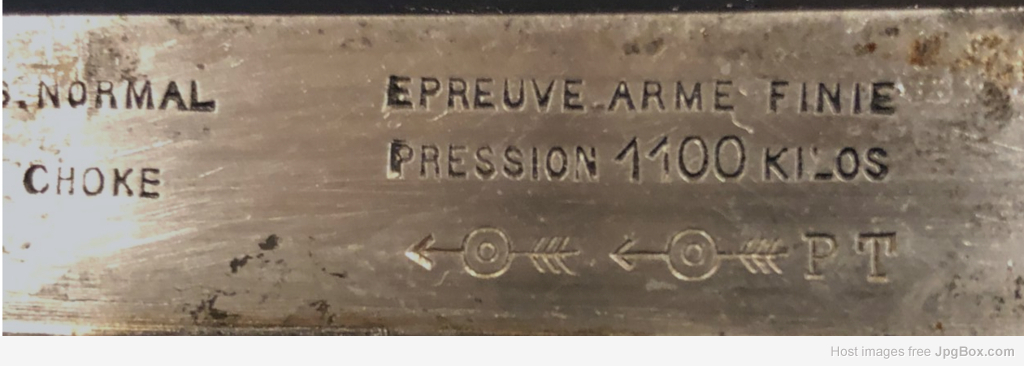
And when you look at the crossed canon and arrow logo of Manufrance, it seems pretty clear that the above arrow proof mark comes right out of the MF logo.
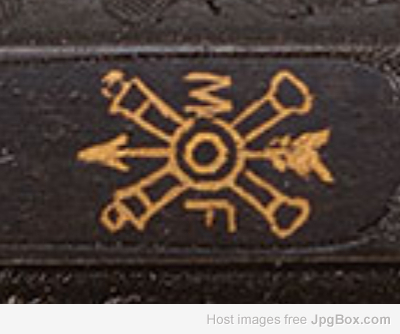
This conclusion is reinforced by the crossed fronds on the OP gun...without the crown.
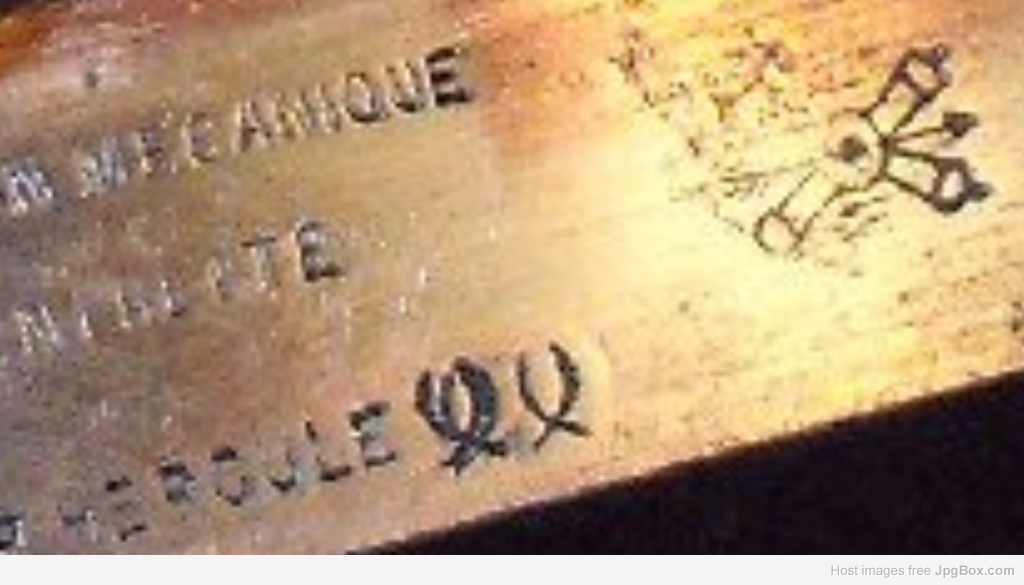
I think we can safely conclude that in the 1920's Manufrance proofed their own guns and thus the arrow through target logo. Since they were manufacturing 500 guns a week - or even more - it would make sense....until proven otherwise.
(Conclusion is another first for this site).
2). Here is an English site with an identical 16 gauge gun to the OP. And he's firing slugs out of it.
https://www.thestalkingdirectory.co.uk/threads/16-bore-french-cape-gun.15636/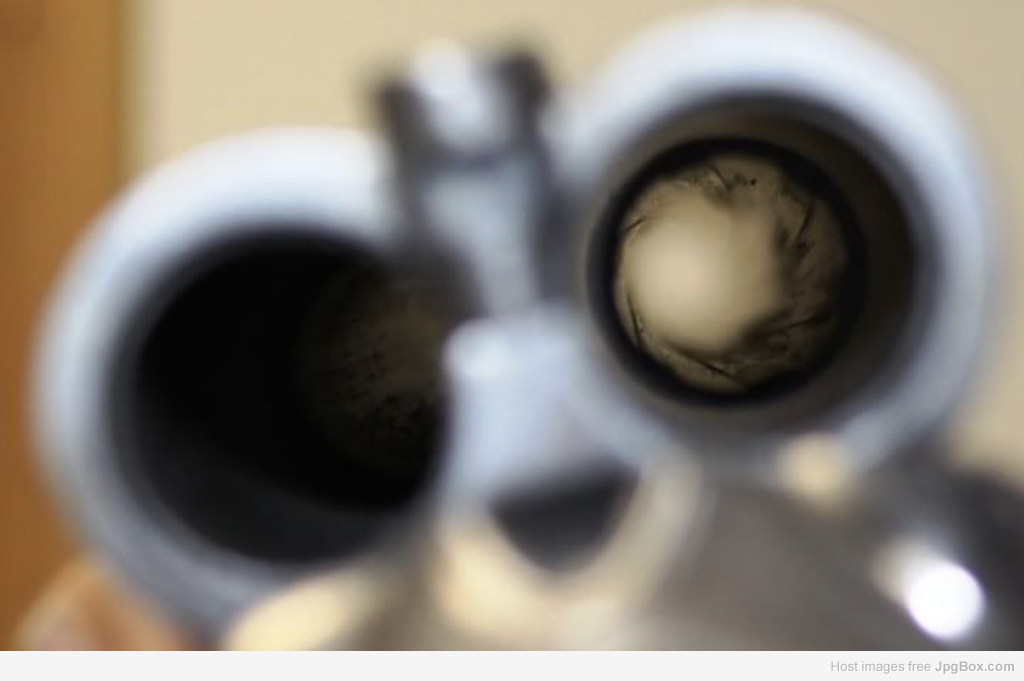
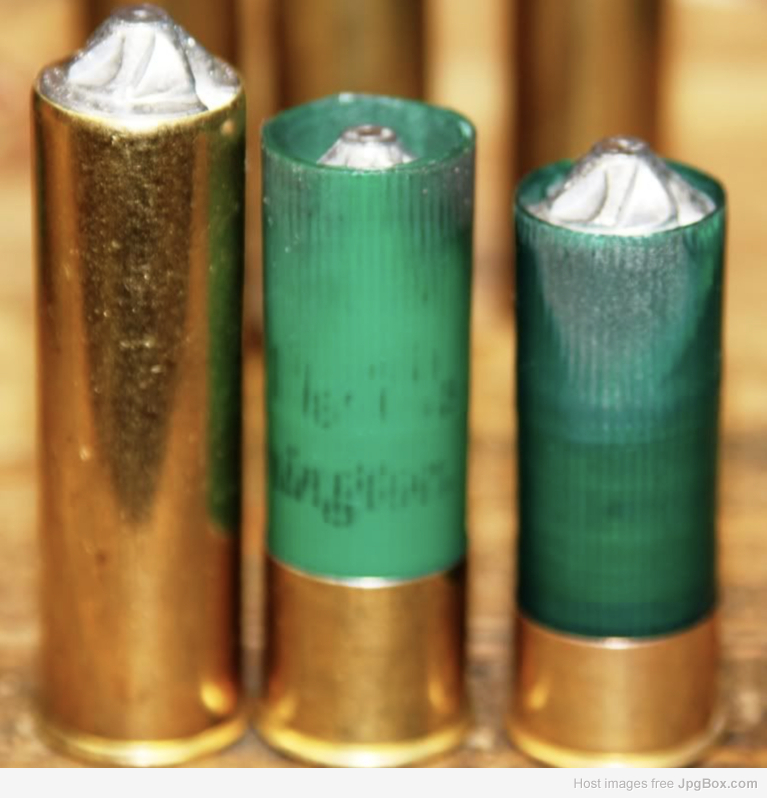
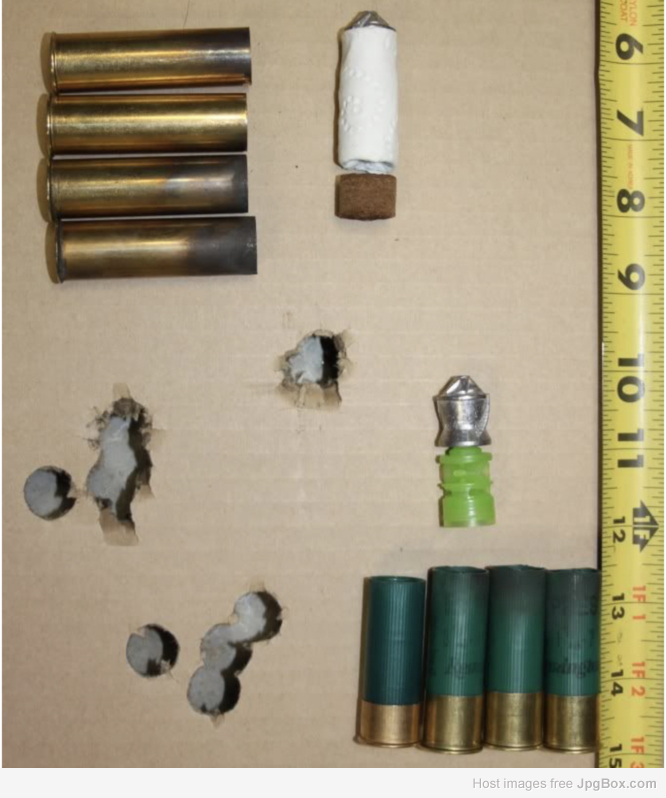
Hello Ted Schefelbein & Der Ami,
Thanks for the replys
buckstix:
" ..... there are two quite different types of rifling seen on manufrance guns...the previously mentioned RAYE which is similar to the english type of rifled bore (paradox, etc.)....it is a section of rifling that is smaller than the bore diameter ("choked"), and about three inches in length from the muzzle...it was intended to swirl the shot as it leaves the muzzle, to provide a wider pattern than a cylinder bore.
the other is what you have purchased, which MF called SUPRA (hence the S in the model designation)...it is an unchoked bore with shallow rifling that is the full length of the barrel...it was built to allow both shot and solid projectiles to be used...my example (12 gauge) has about .716 diameter lands and about .727 grooves, and rotates about 1/2 to 5/8 twist in the length of the barrel...it's not easy to exactly measure these barrels. ...."
tom
Hello graybeardtmm3,
Thanks for the reply.
I see there are two different opinions above about this being a "Cape Gun". The Analytical Engineer in me brings me to this conclusion; I agree with you, I think the rifled barrel would do well with both Shot & Ball. Both Paradox Guns, and Shot & Ball Guns, typically have identical side-by-side barrels. So perhaps this gun would be best described as a "Combination Gun", or a true "Ball & Shot Gun". It would be interesting to locate an original 1930s advertisement for this Combination Gun to see how it was described to the Sporting World. But I don't think I'm off base calling it a Cape Gun.
I did a cast of 1 inch of the muzzle, and it measured .662 groove, and .652 bore, with 6 lands and grooves. Lands measure .140" wide, and grooves measure .200" wide. Rotation of the rifling appears to be slight over 1/2 rotation over the 27-1/2" length of the barrel. Seems it would be perfect for a patched ball of .662 dia.
I would guess that the lack of a rear sight would indicate the right barrel, when loaded with a ball, would be used at fairly close range. I will be testing to find out, and post the results here.
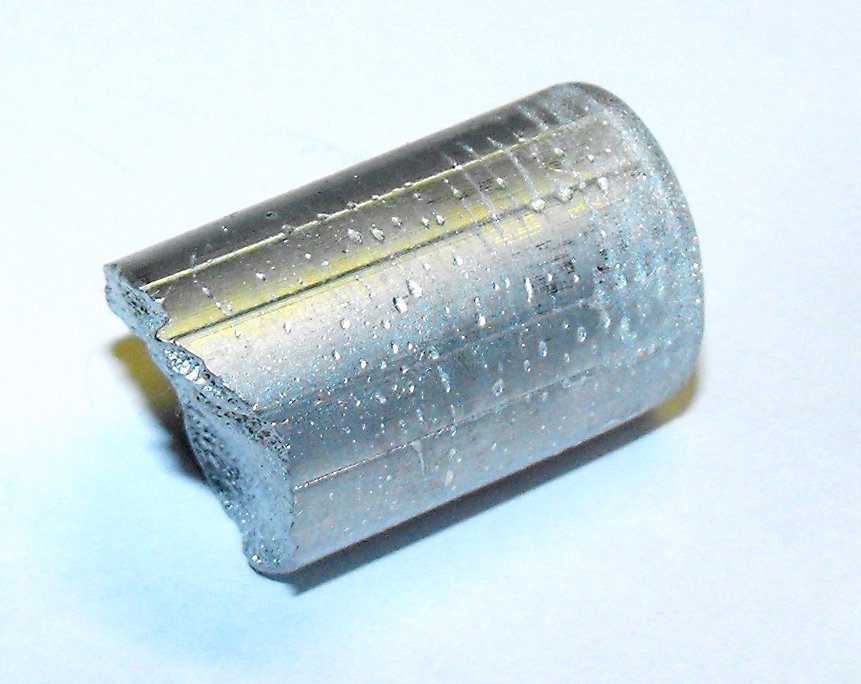
Might as well repost this. Last February Gil asked me to take a look at this article on "Raye" barrels - see last paragraph.
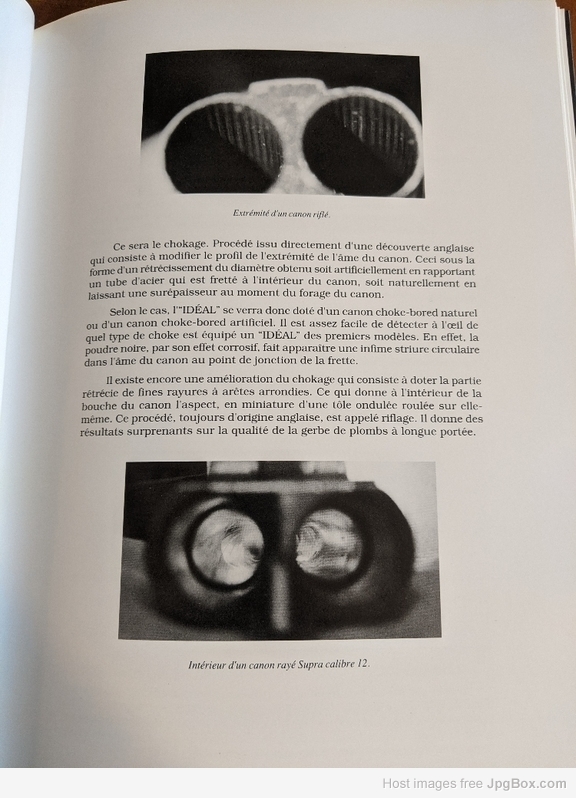
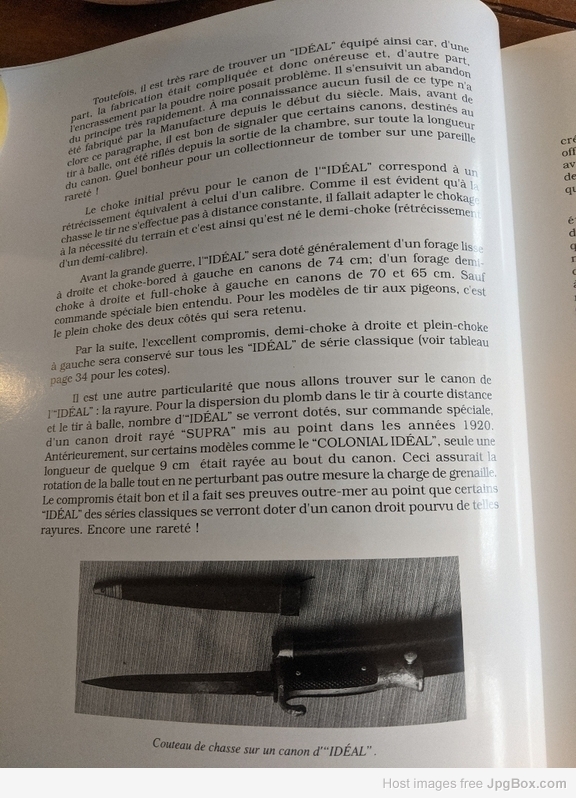
Here was my response:
Gil, about the best I can do for the moment. I thought I had all the French gun terms down...fat chance. I could not get the impression that a barrel insert could be put into a smooth bore from this article. My impression is the two pages dealt with:
1) traditional Greener type choke boring
2) artificial choke boring by casting a rifled ring at the muzzle of the gun
3) rifling the length of the choke which seemed to increase the range of the shot but gave problems with fouling using black powder.
4) rifling the full length of a bore, meant for shooting shot and ball
5) rifling about 8 cm of the part of an unchoked bore directly in front of the chamber which allowed a ball to rotate but allowed normal "spreader" use of 4-9 shot.
Wildcattle probably could give a better translation but I think this is the gist:That will be the chokes. These came directly from a English discovery which consisted of modifying the profile of the end of the bore of the barrel. These were a form of constricting the diameter of the bore achieved artificially by laying a (small) tube of rifled steel in the interior of the barrel (at the muzzle) naturally leaving a supression at the moment of the casting of the barrel
In the case of l’IDEAL, is was thus developed barrels naturally choke-bored and those artifically choke-bored. It is quite easy to detect with the eye which type of choke an IDEAL is equiped with in the first models. In effect the black powder, by its corrosiveness, left a tiny circular streak in the bore of the barrel at the point of the junction with the monobloc.
There exists yet another combination of choke systems which consists of putting fine stripes on the tapering of the choke on the rounded edges. This gives to the interior of the mouth of the barrel the aspect in miniature of a crinkled tapered tube. This process, also of English origin, is called rifling. It gives surprising results in the the long range of the pellets.
Nevertheless, it is very rare to find an IDEAL so equipped because on one part the fabrication was complicated and thus onerous and, on the other part, the fouling by black powder posed a problem. This led them rapidly to abandon the concept. To my knowledge no long gun of this type has been made by the Manufacturer since the beginning of the century. But, before closing this paragraph, it’s worth noting that certain barrels, meant for firing ball, were rifled from the exit of the chamber, along the entire length of the barrel. What happiness for a collecter to come upon such a rarity.
The choke initially seen on the barrel of the IDEAL corresponded to a constriction equivalent to that of one caliber. As it is evident that shooting during a hunt doesn’t take place at a constant distance, it was necessary to adapt the chokes according to the ground and thus also was born the half-choke (constriction by a half caliber)
Before the great war, the IDEAL generally carried an open smoothbore barrel on the right and a choke-bored one on the left for barrels 74 cm in length. Bores with half choke on right and full choke on the left on barrels from 65-70 cm. Except for special orders of course. For pigeon shooting models, full choke on both sides was the norm.
Thereafter, that excelent compromise, half-choke on the right and full-choke on the left were kept on all the classic series IDEALs. (see the tables on page 34).
There is another particularity which we are going to find on the barrels of the IDEAL. The (shallow) rifling. For the dispersion of shot when firing at a short distance and for the shooting of ball, a number of IDEAL came, on special order, with the right barrel (unchoked) rifled “SUPRA” beginning in the 1920’s. Previously, on certain models such as the COLONIAL IDEAL, only one length of some 8 cm was striated (rifled) at the beginning of the barrel. This assured the rotation of the ball without perturbing in the slightest the smaller shot. The compromise was a good one and it made its mark abroad to the point that certain of the classic series can be seen with the right barrel provided with such rifling. Such a rarity.
Might as well repost this. Last February Gil asked me to take a look at this article on "Raye" barrels - see last paragraph. ....
" ... There is another particularity which we are going to find on the barrels of the IDEAL. The (shallow) rifling. For the dispersion of shot when firing at a short distance and for the shooting of ball, a number of IDEAL came, on special order, with the right barrel (unchoked) rifled “SUPRA” beginning in the 1920’s. ...."
Hello Agro44,
Thanks for the reply.
I guess that settles it. The shallow rifling was intended for shooting Ball, ...
AND ... for the dispersion of shot at close distances.
So ... a Cape Gun ... or Combination Gun ? ? ?
Thank you for this information.
In theory, yes. In practice, well, you will soon see.
Europeans often suffer restrictions on what kind and how many guns they can own, along with similar restrictions on ammunition forms. Other opinions differ, but, combination guns, to me, always seem to be the worst kind of compromise. Firing a 16 gauge slug out of that gun wouldn’t be a pleasant experience, and the straight stock, light weight, and single bead sight aren’t going to help matters, with regard to accuracy.
I’d be very interested in seeing your results, on paper, with your gun. Unstabilized
round balls have never impressed me as far as accuracy was concerned (they do, in normal shotgun bore sizing, hit like a ton of bricks, however) but, I’d be willing to bet that the non rifled barrel actually is more accurate with rifled slugs, then the rifled barrel is with pumpkin ball slugs. Ditto the results with bird shot in the rifled barrel. It would be pleasant, in this case, to be proven wrong.
Love to see those results as well.
Let us know.
Best,
Ted
Buckstix; Why not try fabricating a couple of those slugs as illustrated on the English site above and comparing them with a similar charge with ball - shot from your right barrel. I understand rifled slugs on standard modern shot gun smooth bore slug barrels don't really rotate yet can put in a 4" group at 100 yards.. Still it would be interesting to look at ball and slug groups from your "raye" barrel per the English post above.
Also for history, I'd love to see patterns from that same barrel in say #6 shot. and compare them to your left barrel. Sounds like the research proposed by Ted would be interesting to all. Gene
Buckstix; Why not try fabricating a couple of those slugs as illustrated on the English site above and comparing them with a similar charge with ball - shot from your right barrel. I understand rifled slugs on standard modern shot gun smooth bore slug barrels don't really rotate yet can put in a 4" group at 100 yards.. Still it would be interesting to look at ball and slug groups from your "raye" barrel per the English post above.
Also for history, I'd love to see patterns from that same barrel in say #6 shot. and compare them to your left barrel. Sounds like the research proposed by Ted would be interesting to all. Gene
Hello Argo44
Thanks for the reply.
Unfortunately I'm very reluctant to put much credence in what Ted Schefelbein had to say, based on his earlier post where he stated very matter-of-factly;
" .... Raye barrels are NOT intended for slugs. ... " The last paragraph in your translation of the French publication clearly stated; " ... The (shallow) rifling. For the dispersion of shot when firing at a short distance and for the shooting of ball, ..."
I especially like the line that reads; "... it’s worth noting that certain barrels, meant for firing ball, were rifled from the exit of the chamber, along the entire length of the barrel. What happiness for a collecter to come upon such a rarity. ..."
This leaves no doubt that rifling the full length of a bore was meant for shooting ball. I really appreciate that info.
I've found on many occasions that information on various forums is solely based on opinion, rather than actual fact from field testing. Coming from an R&D Research background, I always try to stick to tested facts, rather than conjecture and opinion.
Interestingly, my Thomas Bland Paradox 12 bore also has shallow (invisible) rifling, and my tests have shown that it performs equally well with both shot and ball. "Ball" meaning the 790g bullet that I cast from the mold that is numbered to / and came with the gun. Thomas Bland advertisements from the period did not refer to this as a Paradox Gun, they called it a "Rifled Ball & Shot Gun". The terminology "Ball & Shot Gun" is also used on the rib between the barrels.
https://www.doublegunshop.com/forums/ubbthreads.php?ubb=showflat&Number=559513&page=allI questioned here on this Forum about the proof marks on this double, but discussion about it being called a Cape Gun have come up. The other Cape Guns in my collection have Rifle / Shotgun barrels, rather than Shotgun / Shotgun barrels, with one barrel being rifled. Although this was advertised as a Cape Gun, and it is by definition, perhaps an appropriate description - "Ball & Shot Gun" would have been better. Hence all the discussion. I primarily wanted to know the meaning of the numerous proof and other marking on the gun.
As for testing, I've got a lot of experiments to conduct in the next few months on projects that were underway before I acquired this Manufrance gun. But I intend to thoroughly test it with both shot and ball (slug) and will publish the results. Number 6 shot from both barrels at 25 yards, and slugs & round balls from both barrels at 50 yards.
The small bead front sight with no rear sight would be difficult to use beyond 50 yards. Here in Wisconsin most whitetail deer are taken at 50 yards or under, so this distance should be an adequate test of the gun. Although the gun is fairly light weight, recoil shouldn't be a problem for me. I'm used to heavy recoil since I shoot my 600NE and 700NE regularly.
Buck, Ted is a world renowned expert on Darnes. He's dealt in French guns for 45 years. He can be pretty abrupt sometimes - a lot of us are - but one should not discount what he says. I just insert comment here and there because I speak the language, not as well as Wild Cattle but good enough. And I have in-laws in Saint Etienne/Saint Chamond area and am interested in the subject, seeing as how wife and kids are dual Franco-American citizens..
I'm not sure that the French "Raye" barrel guns should be considered "Cape Guns." The "Raye" barrel appears to me to be mostly a shotgun attachment not a pure rifle barrel. In any event Ted's observations are from experience. I happen to believe that this barrel was conceived in about 1928 as a way to fire ball out of a shotgun and still leave it a shotgun to shoot a spreader-round at Becasse. I think the advertisements and articles speak for themselves.
It looks like with your engineering background (I have two brothers and a step-father who were engineers) you also have the curiosity and wherewithal to educate us in the future much like the UK poster from 2006 experimenting with an identical gun. This will truly be interesting...as posted, the curiosity about these guns periodically spikes. They are not common.
Take care. Gene.
edit: and I agree on the assessment of the "raye" striated barrels - they are meant for both ball and shot.
Without getting too much into the weeds, the slow twist( 1/2 to 5/8 rev. in barrel length) suggests round balls may perform better than slugs.
Mike
Without getting too much into the weeds, the slow twist( 1/2 to 5/8 rev. in barrel length) suggests round balls may perform better than slugs.
Mike
Hello Der Ami,
Thanks for the reply.
This twist rate is about the same as what is in my Thomas Bland Paradox Gun. Since stabilization is based on bullet length, not weight, the Thomas Bland gun shoots the short fat bullets quite well. Those bullets are over 700g but only slightly longer than bore dia.
buckstix,
My concern was the length, your experience handloading this type ammo is obviously superior to mine.
Mike
The weather is suppose to be nice ... so tomorrow we test the Manufrance 16 bore with both shot and ball. I'll post the results here.
Somewhere along the line, it sticks in my mind that the rate of twist was different for slug barrels vs spreader barrels. There's also the fact that shotguns with one spreader barrel (often both barrels are short as well) are referred to as a "becassier" model. A woodcock special.
I have a Verney-Carron catalog from 1999. There are 2 OU's specifically listed as "becassier" models. On both, the lower barrel is described as "raye dispersant" (spreader barrel). It's interesting that their 12ga "gros gibier" (big game) model comes with both barrels cylinder.
Somewhere along the line, it sticks in my mind that the rate of twist was different for slug barrels vs spreader barrels. There's also the fact that shotguns with one spreader barrel (often both barrels are short as well) are referred to as a "becassier" model. A woodcock special. ....
Hello L. Brown,
Thanks for the reply.
I did my first testing today, and I think this paragraph from Argo44 earlier post pretty much describes the gun I have.....
" ... There is another particularity which we are going to find on the barrels ..... The (shallow) rifling. For the dispersion of shot when firing at a short distance and for the shooting of ball...."The targets below show the results of today's testing. I started very conservative, and will increase velocities carefully in my next load testing. I anticipate with the correct load the gun will shoot more to point of aim. I will be adjusting both velocity and bullet weight to try to achieve this. Its a little hard getting used to a swap rib and a single bead for aiming the rifled barrel. I think a lot of the dispersion was due to that. I'm sure I'll get better as I become more familiar with this sighting system. I'm guessing the option of shooting a ball, was intended as a way to take advantage of as unexpected opportunity for a deer, or boar, at reasonably close distance.
Of particular note is that both the light weight 1oz hollow base bullets, and the heavy 1-1/2oz bullets stabilized in the slow twist of the rifled barrel, as evidenced by round holes, in close groups. I did not shoot either bullet in the smooth bore barrel.
I tested first with shotshell on the 17" square target. A mild target load of 7-1/2s. The shotshell fired from the left smooth bore barrel patterned a bit high, but shows a good pattern from its modified choke. However, the shotshell fired at 25 yards from the rifled barrel shows only 23 pellets of the 338 pellets in the cartridge. (black circles) I fired a second shell in the rifled barrel from 12 yards and that shows a very uniform pattern. (red circles) This barrel would be excellent for close shooting of flushed game, or driven game, with the ability for a follow-up shot from the left barrel if the range increased.
Next I tested the rifled barrel. Some years ago I had a custom bullet mold made for the 1-1/2oz (655g) .676 dia. 16 gauge bullet, as per the German bullets for Vogel Schiessen rifles, of which I have two. One in 18 gauge and one in 16 gauge. The bullet casts .676 and was sized to .660 dia for this gun's bore. The hollow base 1oz bullet is from a Lyman mold and casts a .695 dia. slug. Although the groove dia of this gun is .660, the soft hollow bullet swages down through the forcing cone with no effect on pressure. I did not lube either bullet. I drip 6 drops of oil in each for the fold openings of the crimp, and store bullet-up. The oil coats the bulllets and is absorbed into the fiber wad below it. This method has worked well in my Paradox gun with no leading. I used the paradox crimping tool I designed (and sell) to hold the bullets in place.
.
.
.
.
.
GERMAN VOGEL SCHIESSEN BULLETS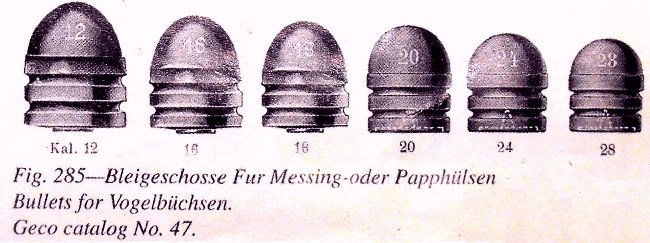
.
.
.
.
.
MY 16 BORE BULLET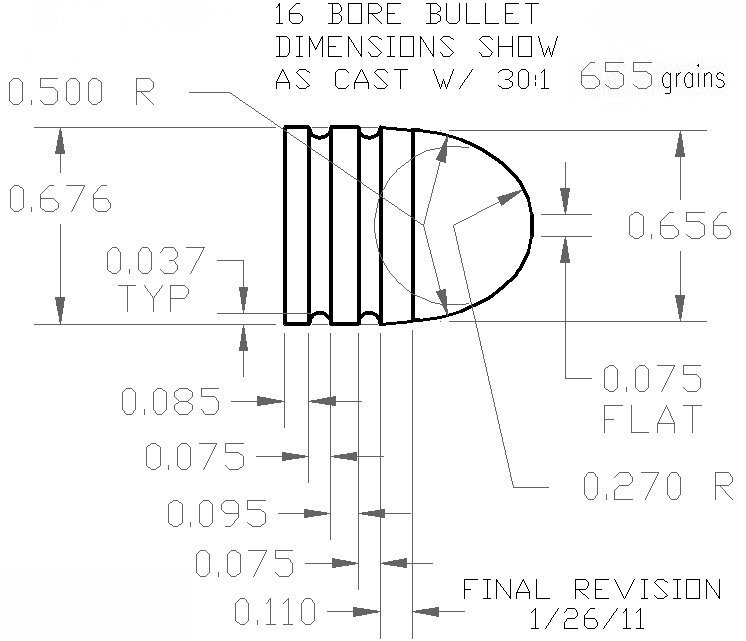
.
.
.
.
.
1-1/2oz 655g BULLET - .676 dia sized down to .660 dia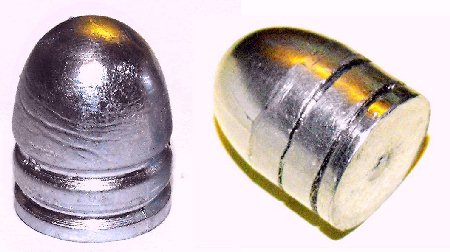
.
.
.
.
.
1oz 438g HOLLOW BASE 16ga SLUG - .695 dia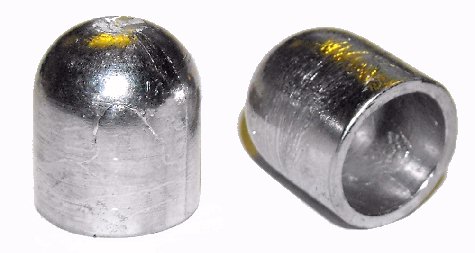
.
.
.
.
.
BULLETS CRIMPED WITH THE CUSTOM PARADOX CRIMPING TOOL - THAT I MAKE & SELL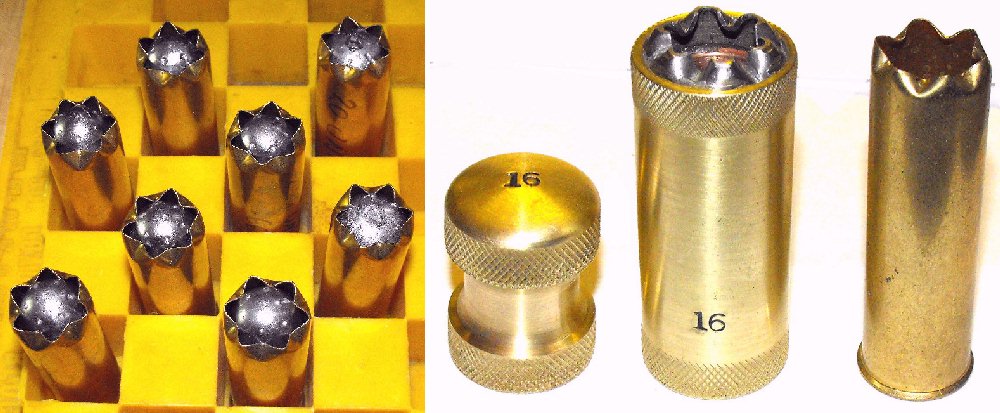
.
.
.
.
.
TARGET SHOWING BULLETS FIRED IN RIFLED BARREL @ 25yds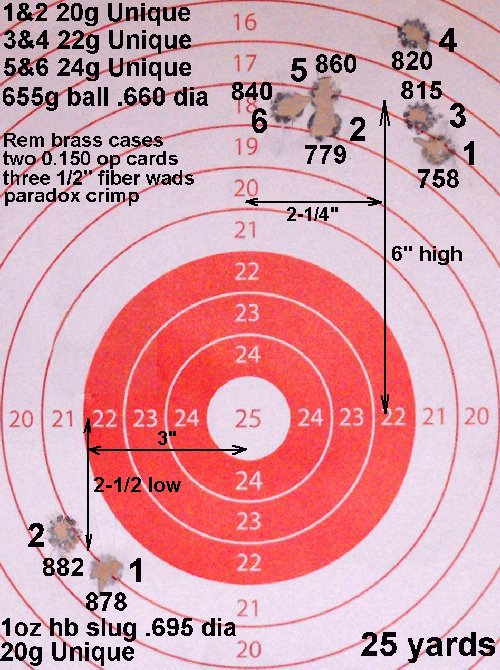
.
.
.
.
.
TARGET SHOWING 1oz #7-1/2 SHOT FIRED IN RIFLED BARREL @ 25yds (BLACK) and @ 12yds (RED) 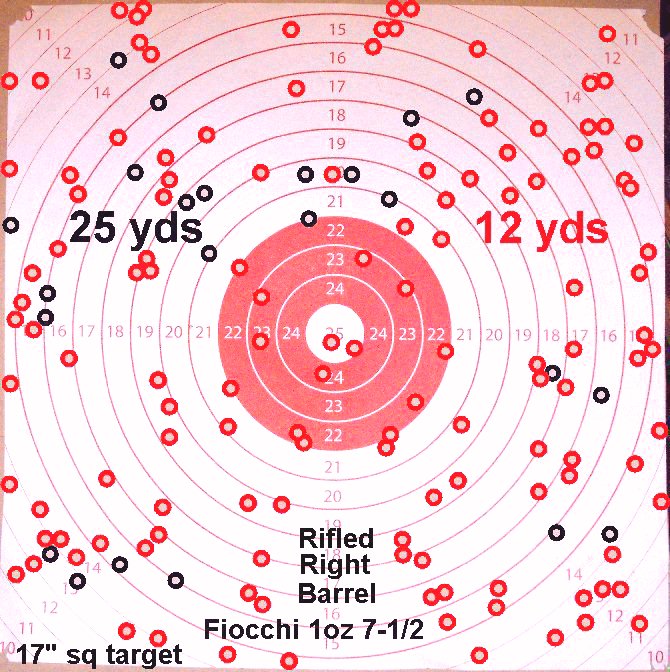
.
.
.
.
.
TARGET SHOWING 1oz #7-1/2 SHOT FIRED IN SMOOTH BORE MOD CHOKE BARREL @ 25yds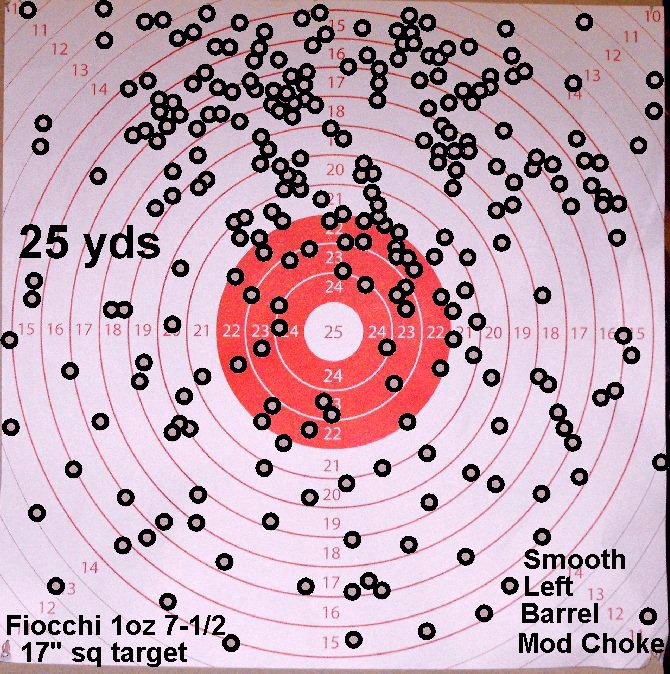
.
.
.
.
.
That Sir....is excellent research. The shot spreader pattern from 25 yards to 12 yards is dramatic. The slug pattern indicates that it indeed was meant to be used with both shot and ball.
buckstix,
Once this thread has run it's course and everyone moves on, I think it would be very informative iv you started another thread under "German and Austrian Sporting Guns" about your two Vogel Bueschen, and loading for them.
Mike
That Sir....is excellent research. The shot spreader pattern from 25 yards to 12 yards is dramatic. The slug pattern indicates that it indeed was meant to be used with both shot and ball.
Hello Argo44,
Thanks for your reply.
Wouldn't it be nice if some of the nay-Sayers admitted that they learned something new?
buckstix,
Once this thread has run it's course and everyone moves on, I think it would be very informative if you started another thread under "German and Austrian Sporting Guns" about your two Vogel Bueschen, and loading for them.
Mike
Hello Der Ami,
Thanks for your reply.
Yes, I can do that. I actually had 3 at one time, but found a fella that wanted to buy one, for more money than I wanted to keep it. So, I sold him the one at the top. The heavy one.
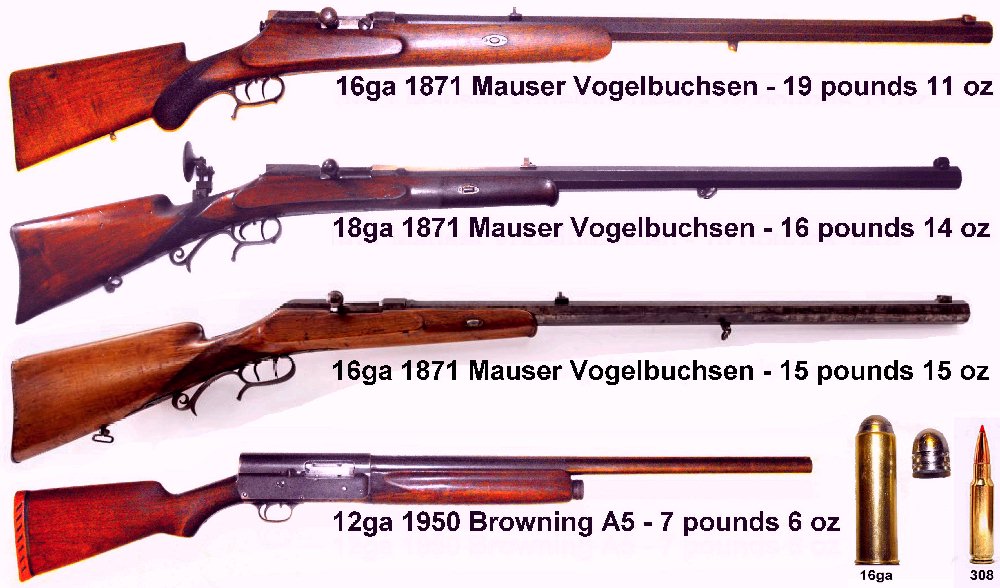
I guess I am a naysayer. One thing I did actually relearn (anything I ever learned about Manufrance was accidental, while trying to learn something about sliding breech guns) is some Manufrance guns did not make a trip through the proof house, and I see no evidence that this gun was government proofed. It would have had the metric measurement of the chambers on the flats, and another key feature noted, Raye Supra rifling.
It has neither. Proof in France was not compulsory, but, for the very most part, it may as well have been. I was told by the proof house master in Saint Etienne that the proof house markings would always tell you everything you needed to know about loading for a gun that had them.
I still don’t believe this is a cape gun. If anyone has evidence otherwise, I’d love to see it.
And, I still believe that, at best, it a compromise gun, built for someone who has little choice in what he can own and carry. At 25 yards, I own shotguns that will pattern buckshot or slug groups that will be superior to the slug pattern shown for hunting big game at that range, out of standard bores and chokes. At 25 yards a lot of shotguns will print better results than what you have shown, above. But, I’d still prefer to be armed with a high powered rifle over either, as a deer at 25 yards distance from a human isn’t usually there very long. Americans are blessed in that they can own either, and make a conscious decision about what they are going to hunt that day. The combination gun thing appeals to few, here. Perhaps you can work that 6” or so group, at 25 yards, down, using a light gun with a single bead sight.
If that was my game (it isn’t ) I have half a dozen better, simpler, and easier options on hand. Just for giggles, you could try running three rifled slugs through the other barrel, and post the results. I would not be the least surprised if it actually works very well, or, even better than what you have shown.
Glad it works, hope it works well for you.
Best,
Ted
" ... I guess I am a naysayer. ... "
" ... I still don’t believe this is a cape gun. If anyone has evidence otherwise, I’d love to see it. ... "
" ... And, I still believe that, at best, it a compromise gun, built for someone who has little choice in what he can own and carry. ..."
" ... At 25 yards, I own shotguns that will pattern buckshot or slug groups that will be superior to the slug pattern shown for hunting big game at that range, out of standard bores and chokes. At 25 yards a lot of shotguns will print better results than what you have shown, above. But, I’d still prefer to be armed with a high powered rifle over either, as a deer at 25 yards distance from a human isn’t usually there very long. Americans are blessed in that they can own either, and make a conscious decision about what they are going to hunt that day. The combination gun thing appeals to few, here. Perhaps you can work that 6” or so group, at 25 yards, down, using a light gun with a single bead sight. ..."
" ...If that was my game (it isn’t ) I have half a dozen better, simpler, and easier options on hand. Just for giggles, you could try running three rifled slugs through the other barrel, and post the results. I would not be the least surprised if it actually works very well, or, even better than what you have shown.
Glad it works, hope it works well for you. ..."
Best,
Ted
Hello Ted Schefelbein,
Thannks for the reply.
I guess I can only agree with your first sentence. You "are" a nay-sayer.
As to not believing this is a Cape Gun, and wanting to see evidence otherwise, you might try reading a dictionary ... "
Cape Gun, noun phrase, Origin, English, A type of double-barrelled firearm, usually with one barrel smooth-bored and the other rifled"... and given that simple definition, it is not my intention to recruit you to agree.
Whether you call this a Cape Gun, or a Combination Gun, or a Ball & Shotgun, or a Shotgun with one rifled barrel, or whatever wiggles-your-wang, my OP was simply to learn about the proof marks - to which you have contributed absolutely nothing.
As for my 25 yard target tests, this distance was merely a starting point for testing - not intended to define a hunting range, nor to recommend the gun for such. If the deep snow at our Gun Club would have been plowed out to the 50 yard range, I'd have started testing at that distance.
As to your comment; "The combination gun thing appeals to few, here" - maybe not to you. Perhaps for this reason you should have kept your "expert" thoughts to yourself and posted elsewhere. The heading to this Forum includes "...to discuss your doubles, drillings,
combination guns..." Also, every Gun Forum on the internet has a section on Combination Guns, with thousands of posts about them, and the collecting of them. These like other firearms are an interesting piece of History to many, of a time when such guns were actually used. So I guess this combination gun thing DOES appeal to more than a few. A simple search will reveal that I have posted about several of my Cape Guns, and Paradox Guns, and Shot & Ball Guns, and many, many have found them appealing.
Others who have followed my many posts on various Gun Forums know my background is in Analytical R&D Engineering. This quest for knowledge has spilled into my firearms interests, which leads me to the testing of Historical Firearms, and the documentation of the results, for myself and for others who may have interest.
So far, you've referenced some of your experiences, lets see your data! Lets see your targets. Lets see the loads that you have developed. Lets see something, anything, besides your written opinions. I searched your posts and found 298 pages, but no real data.
I want thank all those others who have given me interesting information about this gun. I truly appreciate it. I'll post continuing results of my testing soon.
As for your having "have half a dozen better, simpler, and easier options on hand" ... so do I.
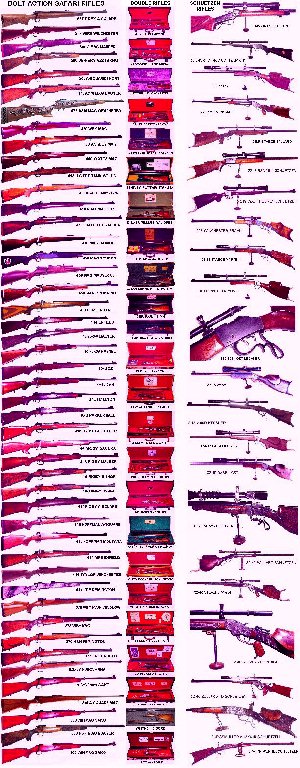
You weren’t paying attention, I guess. I pointed out your gun wasn’t proofed at the proof house in St. Etienne. Further, the mark “Raye” is really incorrect. It is Raye Supra bored. A Manufrance collector might know that by the model number, but, that might not help a guy on an actual cape, trying to use the gun. You don’t have to like it, but the information on the flats of your gun is incomplete and inaccurate. The proof marks that go on the gun when it has passed official government proof are easily researched, and never vague. I don’t find that to be the case on your gun, and, it would seem you don’t, either.
You’re welcome.
If you are going to rely on a dictionary for your definition of what constitutes a cape gun, what do you need this board for? What does your dictionary say an assault rifle is, and, does anyone believe that? Actually, Raimy got it right, better sights would almost have to be part of the equation for someone to consider a gun a cape gun. If it was to truly be versatile that would be a necessity.
I imported a grand total of one slug gun from France, in 20 years of doing that. If there are “many” interested in them, they weren’t opening their wallets to show that. Nobody wanted a rifle on one side, or, a double rifle, or Supra rifling, either. I didn’t sell that gun to you, either. That gun was regulated with Federal rifled slugs to 70 yards, had actual rifle sights on it (the back one folded down for bird hunting) and put two holes on either side of a 2” black spot on the paper, perhaps a bold inch away from each other. Minute of baseball at 70 yards, not minute of watermelon at 25. The gun was choked IC and MOD, and threw wonderful patterns at normal bird gun range. Load development was done with the ammunition the owner of the gun had easy access to. Seems sensible to me. In fact, that is the only thing I would consider doing, develop the gun around a load. I’d love to say the guy who ordered it still had it, but, it went down the road, and nobody ever asked about another.
Enjoy your gun. Not naysaying, either.
Best,
Ted
Hello Ted Schefelbein,
Thanks for your reply.
I think it is "you" that's not paying attention. Let me repeat, I didn't come to this site looking for "your" confirmation of the definition of a Cape Gun. The gun "is-what-it-is". I enjoy adding a unique firearm to my collection. I find it interesting. Others may - or may not.
I find it hard to believe your claim that a Company like Manufrance, who made hundreds of thousands of guns, would have inaccurate and incomplete markings. You've now mentioned twice, what marks this gun doesn't have. How about a detailed translation of those 20-odd marks it "does" have. I might find "that" useful. I've taken the time to take a lot of pictures to show the marks on this gun. Lets see some of your pictures of the marks it doesn't have. I might find "that" useful.
I'm very impressed with your vast experience with "one" slug gun from France. WOW ! "minute of baseball at 70 yards" - compared to "minute of watermelon at 25 yards". Now there's a snappy "one-gun-guru" technical comparison. Lucky I didn't start my testing at 50 yards. It might have shown "minute of bushel basket" in those first TEST targets.
As for French guns, I have a few French Double rifles in my collection. I even had a French Darne 20ga once. I found the "mouse-trap" feature very unconventional and impractical for actual bird hunting. I sent it down the road, quickly, and never asked about another.
For all the "other" Forum members, I'm hoping to get to the range to do some additional load development later in the week. I'll post the resulting targets.
Bonjour tout le monde,
Je suis français et je ne parle pas anglais.
Je pense que le document que je vous ai envoyé pourra vous aider.
La MF avait un banc d'épreuve de 1926 à 1960.
Bonne soirée.
Merci Fab500, et bien venue. Nous avons décidé que l'arm avait un banc d'épreuve de 1930-31. Il y a un livre avec un bilan avec le numero de model et les années de leurs production...ci-dessus.
Et je voudrais savoir comment on peut ajouter un poste sur passionlachasse.fr. J'ai développé un méthode pour daté les fusil de chasse de Saint Etienne des premier decades du XXth Century. (Pardon le Francais, je peut parler mieux).
https://www.doublegunshop.com/forums/ubbthreads.php?ubb=showflat&Number=484199Gene
Ici, on peur voir notre dictionnaire des terms Français-Anglais pour les arms de chasse.
https://www.doublegunshop.com/forums/ubbthreads.php?ubb=showflat&Number=480959#Post480959
fab500 forwarded an article on the Manufrance Proof House which clarifies the proof mark arrows above.

1). As speculated, they are indeed for a Manufrance run proof house
2). They could only be used on guns sold within France. The Official Saint Etienne Proof House was the only one recognized abroad.
(there are metallurgy terms which I have a hard time with - welcome help).
Here is the article with a rough translation:
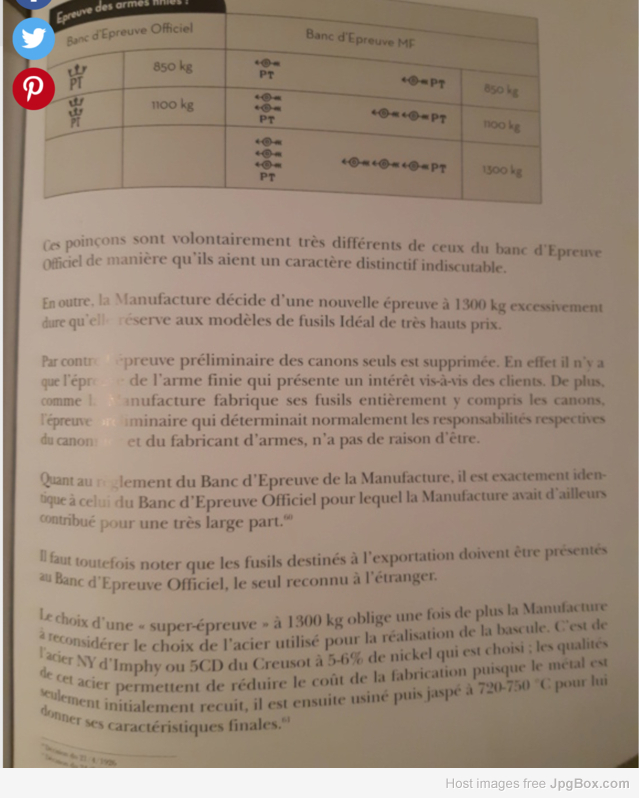
These proof marks are deliberately quite different from those of the Official (Saint Etienne) Proof House in the way that they have an unequivocally distinctive character
Furthermore, the Manufacturer (MF) decided to make a new proof mark at 1300 kg exceedingly hard, which was reserved for models of very high-priced Ideal guns.
In the process, the preliminary proof of single barrels was replaced. In effet there was only the proof of the finished arm, clearly of benefit to the clients. Moreover, as the manufacturer fabricated his entire gun including the barrels the preliminary proof marks which normally separated into respective responsibilities for the barrels and the gun itself, no longer had a reason to exist.
Regarding the regulation process of the Proof House of the Manufacturer, it is exactly identical to those of the official Proof House for which the Manufacturer besides contributed to a very large extent.
It is necessary however to note that the guns intended for export had to be presented to the Official Proof House, the only one recognized abroad.
The choice of a “super-proof” at 1300 kg, required once again that the Manufacturer, reconsider the choice of steel used for creating the action. It is a steel made of “NY d’Imphay” (??) where 5 CD of “steam hammer” (“Creusot”?)?? at 5-6% of nickel which was chosen; the qualities of that steel allowed the reduction of the cost of fabrication since the metal is initially only annealed (“recuit” – new word for the dictionary unfortunately now locked), it is subsequently machined (usiné – another new word) then case-colored hardened at 720-750 degrees celsius to give it its final appearance.
New words for the dictionary:NY D'Imphay? - (some alloy I would suppose)
Creusot? - stream hammered of some sort?
Recuit - annealed
Usiné - machined
Creusot was a famous forging town, possibly a refference to a hammer forged frame?
https://en.wikipedia.org/wiki/Le_Creusot
Hello fab500,
Thanks for the reply.
I wish I understood French
Hello SKB,
Thanks for the reply.
Very interesting reference.
Hello Argo44,
Thanks for the reply.
Again, a Big Thank You for a most informative addition to solving the history puzzle of the Cape Gun's markings.
Hello Argo44
I just received this from a member on another forum.
Could you translate some of the text as it relates to our discussions here?
Thanks
![[Linked Image from buckstix.com]](http://www.buckstix.com/buckpics/manual-6.jpg)
Well, I'll have a go at this but you guys are really taxing my vocabulary. More new words. I'll be making a list to send to Dave so he can post them - since he locked the French dictionary line.
This is a rough translation - but it seems clear that the Raye "SUPRA" barrel was first intended to be a spreader shotgun barrel - and secondarily a rifled ball barrel. I would think this falls between a shotgun and a cape gun...a very interesting concept.
. . . . . . . . . . . . .For upland woods hunting.
New word:
"Le Chasse sous Bois" - upland hunting
For hunting rabbit (in the wild?) as well as Woodcock..
New word
“le déboulé”? in the wild?
. . . . . . . . . . . . . . .Use one of our
Double guns with right barrel “raye” “Supra.”
In order to succeed in various hunts where one must be generally ready to fire, it is necessary that the pattern of the lead shot does not have a tight group, but one which can cover (the target at a distance of about 15 meters), with the widest spreading grouping possible, while remaining regulated and sufficiently “supplied” (“fournie”) –(presumably meaning “get the biggest possible shot dispersion while retaining enough shot to kill something).
New words:
Gerbe – Pattern
Gerbe de Plombe - shot pattern
Fournie - not sure
Of all the previous methods tried to obtain a result, special boring of barrels or particular loading of cartridges, -- nothing has achieved the proposed goal, when, after some thirty years of deep studies and numerous attempts, we have acquired the certainty that the shallow striation of barrels has achieved the searched for solution.
New word:
Forage – boring (of barrels)
This led to the creation of our Rayes SUPRA barrels, with which one obtains, at distance reduced to 12-15 meters, a beautiful shot pattern some 80cm in diameter (figure 2) compared to the pattern from the same distance by a smoothbore barrel (“Canon Lisse”) made to shoot ball. (Fig. 1)
With an arm fitted (“Muni” – new word) with one of our Rayes SUPRA barrels and normally charged cartridges with Nr. 8 shot which are proven best for close-in shooting, the chances of shooting games at close range are doubled; and it poses no risk of tearing the game apart rendering it inedible as with an ordinary shotgun.
New word:
Muni - fitted
Finally and this is not the least interesting part of this perfection, our new Raye barrel permits one to fire a round conical ball or a ball “MF,” with precision sufficient for a distance of 50 to 100 meters.
New words:
Chasse (m) sous Bois - Upland woods hunting
Déboulé (m)? - in the wild?
Forage – boring (of barrels
Fournie - not sure
Gerbe – pattern
Gerbe de Plombe - shot pattern
Muni - fitted
" ... This is a rough translation - but it seems clear that the Raye "SUPRA" barrel was first intended to be a spreader shotgun barrel - and secondarily a rifled ball barrel. I would think this falls between a shotgun and a cape gun...a very interesting concept.
Hello Argo44,
Thanks for the reply.
You have done a wonderful job of translating. Thank you so much.
I'm very pleased to have acquired a copy of this pamphlet that proves that the Factory intended the rifled barrel to be used with
both shot and ball.".... our new Raye barrel permits one to fire a round conical ball or a ball “MF,” with precision sufficient for a distance of 50 to 100 meters.Interesting is the coincidence that I tested the shotshell pattern of the right barrel at 12 yards, and the pamphlet indicates 12-15 meters. Pretty close.
As I develop my "ball" loads, I'll stretch the testing to 50 - 100 yards to see how it performs. Nothing like rediscovering the 1930's.
BTW, I've had several PMs conversations with forum members here, and from other forums, telling me that this is a very, very, rare gun.

If you look at the 2nd page graybeardtmm3's post, Tom absolutely nailed it without lifting a finger. There are some real authorities on this board. Hopefully we've added some academic footnotes reinforcing his conclusions.
If you look at the 2nd page graybeardtmm3's post, Tom absolutely nailed it without lifting a finger. There are some real authorities on this board. Hopefully we've added some academic footnotes reinforcing his conclusions.
Hello Argo44,
Thanks for your reply.
Yes, graybeardtmm3's post DID nail it. He was SPOT-ON. It was his assement that led me to do the cast of the rifling - a picture of which is in my post that followed his.
For my part - I will continue to refer to this interesting Combination Gun, .... as a
CAPE GUN.
Although "some" think there is not much interest in Cape Guns, I'll post details about the other four in my collection for those that do have interest.
My first Cape Gun.
https://www.doublegunshop.com/forums/ubbthreads.php?ubb=showflat&Number=589330#Post589330My second Cape Gun
https://www.doublegunshop.com/forums/ubbthreads.php?ubb=showflat&Number=589328#Post589328My third Cape Gun
https://www.doublegunshop.com/forums/ubbthreads.php?ubb=showflat&Number=589325#Post589325My forth Cape Gun
https://www.doublegunshop.com/forums/ubbthreads.php?ubb=showflat&Number=589323#Post589323And as you know ... this post was about my fifth "Cape Gun".
https://www.doublegunshop.com/forums/ubbthreads.php?ubb=showflat&Number=587568#Post587568.... and ... I'm bidding on a couple more in various up-coming auctions - wish me luck.
Mr. Buckstix: In reviewing this post after discussing a Bulgarian SxS Manufrance owner with a "raye" barrel, we need an update on your effort to expand you cape-gun collection. Thanks.
Also to help in dating Robusts from the other line above, what is the SN of your 32-ES? Thanks.






![[Linked Image from jpgbox.com]](https://www.jpgbox.com/jpg/54838_481x768.jpg)
![[Linked Image from jpgbox.com]](https://www.jpgbox.com/jpg/54839_547x768.jpg)
![[Linked Image from jpgbox.com]](https://www.jpgbox.com/jpg/54840_485x768.jpg)





















![[Linked Image from buckstix.com]](http://www.buckstix.com/buckpics/manual-6.jpg)